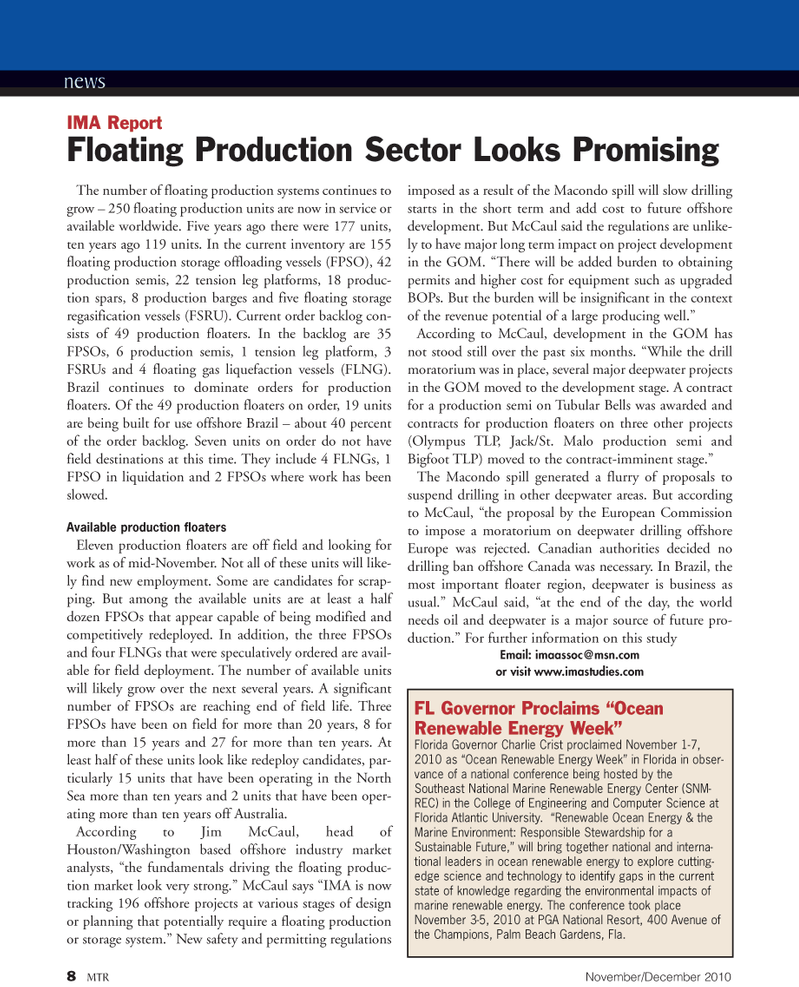
Page 8: of Marine Technology Magazine (November 2010)
Fresh Water Monitoring and Sensors(lakes, rivers, reservoirs)
Read this page in Pdf, Flash or Html5 edition of November 2010 Marine Technology Magazine
8 MTR November/December 2010 news
The number of floating production systems continues to grow – 250 floating production units are now in service or available worldwide. Five years ago there were 177 units, ten years ago 119 units. In the current inventory are 155 floating production storage offloading vessels (FPSO), 42 production semis, 22 tension leg platforms, 18 produc- tion spars, 8 production barges and five floating storage regasification vessels (FSRU). Current order backlog con- sists of 49 production floaters. In the backlog are 35
FPSOs, 6 production semis, 1 tension leg platform, 3
FSRUs and 4 floating gas liquefaction vessels (FLNG).
Brazil continues to dominate orders for production floaters. Of the 49 production floaters on order, 19 units are being built for use offshore Brazil – about 40 percent of the order backlog. Seven units on order do not have field destinations at this time. They include 4 FLNGs, 1
FPSO in liquidation and 2 FPSOs where work has been slowed.
Available production floaters
Eleven production floaters are off field and looking for work as of mid-November. Not all of these units will like- ly find new employment. Some are candidates for scrap- ping. But among the available units are at least a half dozen FPSOs that appear capable of being modified and competitively redeployed. In addition, the three FPSOs and four FLNGs that were speculatively ordered are avail- able for field deployment. The number of available units will likely grow over the next several years. A significant number of FPSOs are reaching end of field life. Three
FPSOs have been on field for more than 20 years, 8 for more than 15 years and 27 for more than ten years. At least half of these units look like redeploy candidates, par- ticularly 15 units that have been operating in the North
Sea more than ten years and 2 units that have been oper- ating more than ten years off Australia.
According to Jim McCaul, head of
Houston/Washington based offshore industry market analysts, “the fundamentals driving the floating produc- tion market look very strong.” McCaul says “IMA is now tracking 196 offshore projects at various stages of design or planning that potentially require a floating production or storage system.” New safety and permitting regulations imposed as a result of the Macondo spill will slow drilling starts in the short term and add cost to future offshore development. But McCaul said the regulations are unlike- ly to have major long term impact on project development in the GOM. “There will be added burden to obtaining permits and higher cost for equipment such as upgraded
BOPs. But the burden will be insignificant in the context of the revenue potential of a large producing well.”
According to McCaul, development in the GOM has not stood still over the past six months. “While the drill moratorium was in place, several major deepwater projects in the GOM moved to the development stage. A contract for a production semi on Tubular Bells was awarded and contracts for production floaters on three other projects (Olympus TLP, Jack/St. Malo production semi and
Bigfoot TLP) moved to the contract-imminent stage.”
The Macondo spill generated a flurry of proposals to suspend drilling in other deepwater areas. But according to McCaul, “the proposal by the European Commission to impose a moratorium on deepwater drilling offshore
Europe was rejected. Canadian authorities decided no drilling ban offshore Canada was necessary. In Brazil, the most important floater region, deepwater is business as usual.” McCaul said, “at the end of the day, the world needs oil and deepwater is a major source of future pro- duction.” For further information on this study
Email: imaassoc@ msn.com or visit www.imastudies.com
IMA Report
Floating Production Sector Looks Promising
FL Governor Proclaims “Ocean
Renewable Energy Week”
Florida Governor Charlie Crist proclaimed November 1-7, 2010 as “Ocean Renewable Energy Week” in Florida in obser- vance of a national conference being hosted by the
Southeast National Marine Renewable Energy Center (SNM-
REC) in the College of Engineering and Computer Science at
Florida Atlantic University. “Renewable Ocean Energy & the
Marine Environment: Responsible Stewardship for a
Sustainable Future,” will bring together national and interna- tional leaders in ocean renewable energy to explore cutting- edge science and technology to identify gaps in the current state of knowledge regarding the environmental impacts of marine renewable energy. The conference took place
November 3-5, 2010 at PGA National Resort, 400 Avenue of the Champions, Palm Beach Gardens, Fla.

 7
7

 9
9
